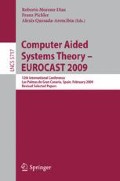Abstract
The framework of this paper is robot localization inside buildings using WiFi signal strength measure. This localization is usually made up of two phases: training and estimation stages. In the former the WiFi signal strength of all visible Access Points (APs) are collected and stored in a database or Wifi map, while in the latter the signal strengths received from all APs at a certain position are compared with the WiFi map to estimate the robot location. This work proposes the use of Fuzzy Rule-based Classification in order to obtain the robot position during the estimation stage, after a short training stage where only a few significant WiFi measures are needed. As a result, the proposed method is easily adaptable to new environments where triangulation algorithms can not be applied since the AP physical location is unknown. It has been tested in a real environment using our own robotic platform. Experimental results are better than those achieved by other classical methods.
Access this chapter
Tax calculation will be finalised at checkout
Purchases are for personal use only
Preview
Unable to display preview. Download preview PDF.
References
Want, R., Hopper, A., Falco, V., Gibbons, J.: The active badge location system. ACM Transactions on Information Systems 10, 91–102 (1992)
Krumm, J., Harris, S., Meyers, B., Brumitt, B., Hale, M., Shafer, S.: Multi-camera multi-person tracking for easy living. In: Proc. of 3rd IEEE International Workshop on Visual Surveillance, pp. 3–10 (2002)
Priyantha, N., Chakraborthy, A., Balakrishnan, H.: The cricket location support system. In: Proc. of the 6th ACM MobiCom, pp. 155–164 (2002)
Barber, R., Mata, M., Boada, M., Armingol, J., Salichs, M.: A perception system based on laser information for mobile robot topologic navigation. In: Proc. of 28th Annual Conference of the IEEE Industrial Electronics Society, pp. 2779–2784 (2002)
Bahl, P., Padmanabhan, V.: Radar: A, in-building rf-based user location and tracking system. In: Proc. of the IEEE Infocom, pp. 775–784 (2000)
LaMarca, A., et al.: Place lab: Device positioning using radio beacons in the wild. In: Gellersen, H.-W., Want, R., Schmidt, A. (eds.) PERVASIVE 2005. LNCS, vol. 3468, pp. 116–133. Springer, Heidelberg (2005)
Enge, P., Misra, P.: Special issue on gps: The global positioning system. In: Proc. of the IEEE, vol. 87, pp. 3–172 (1999)
Serrano, O., Cañas, J., Matellán, V., Rodero, L.: Robot localization using wifi signal without intensity map. In: Proc. of the V Workshop Agentes Físicos (WAF 2004), pp. 79–88 (2004)
Howard, A., Siddiqi, S., Sukhatme, G.: An experimental study of localization using wireless ethernet. In: Proc. of the International Conference on Field and Service Robotics (2003)
Ladd, A., Bekris, K., Rudys, A., Marceu, G., Kavraki, L., Wallach, D.: Robotics-based location sensing using wireless ethernet. In: Proc. of the MOBICOM 2002 (2002)
Youssef, M., Agrawala, A., Shankar, A.: Wlan location determination via clustering and probability distributions. In: Proc. of the IEEE PerCom 2003 (2003)
Sotelo, M.A., Ocaña, M., Bergasa, L.M., Flores, R., Marrón, M., García, M.A.: Low level controller for a pomdp based on wifi observations. Robot. Auton. Syst. 55(2), 132–145 (2007)
Zadeh, L.A.: Fuzzy sets. Information and Control 8, 338–353 (1965)
Zadeh, L.A.: The concept of a linguistic variable and its application to approximate reasoning. Parts I, II, and III. Information Sciences 8, 8, 9, 199–249, 301–357, 43–80 (1975)
Mamdani, E.H.: Application of fuzzy logic to approximate reasoning using linguistic systems. IEEE Transactions on Computers 26(12), 1182–1191 (1977)
Wang, L.X.: Fuzzy systems are universal approximators. In: First IEEE Conference on Fuzzy Systems, San Diego, pp. 1163–1169 (1992)
Alonso, J.M., Guillaume, S., Magdalena, L.: Kbct: A knowledge management tool for fuzzy inference systems. In: Free software under GPL license (2003), http://www.mat.upm.es/projects/advocate/kbct.htm
Alonso, J.M., Magdalena, L., Guillaume, S.: HILK: A new methodology for designing highly interpretable linguistic knowledge bases using the fuzzy logic formalism. International Journal of Intelligent Systems 23(7), 761–794 (2008)
Ruspini, E.H.: A new approach to clustering. Information and Control 15(1), 22–32 (1969)
Hüllermeier, E.: Fuzzy methods in machine learning and data mining: Status and prospects. Fuzzy Sets and Systems 156, 387–406 (2005)
Ichihashi, H., Shirai, T., Nagasaka, K., Miyoshi, T.: Neuro-fuzzy ID3: A method of inducing fuzzy decision trees with linear programming for maximizing entropy and an algebraic method for incremental learning. Fuzzy Sets and Systems 81, 157–167 (1996)
Quinlan, J.R.: Induction of decision trees. Machine Learning 1, 81–106 (1986)
Author information
Authors and Affiliations
Editor information
Editors and Affiliations
Rights and permissions
Copyright information
© 2009 Springer-Verlag Berlin Heidelberg
About this paper
Cite this paper
Alonso, J.M., Ocaña, M., Sotelo, M.A., Bergasa, L.M., Magdalena, L. (2009). WiFi Localization System Using Fuzzy Rule-Based Classification. In: Moreno-Díaz, R., Pichler, F., Quesada-Arencibia, A. (eds) Computer Aided Systems Theory - EUROCAST 2009. EUROCAST 2009. Lecture Notes in Computer Science, vol 5717. Springer, Berlin, Heidelberg. https://doi.org/10.1007/978-3-642-04772-5_50
Download citation
DOI: https://doi.org/10.1007/978-3-642-04772-5_50
Publisher Name: Springer, Berlin, Heidelberg
Print ISBN: 978-3-642-04771-8
Online ISBN: 978-3-642-04772-5
eBook Packages: Computer ScienceComputer Science (R0)

